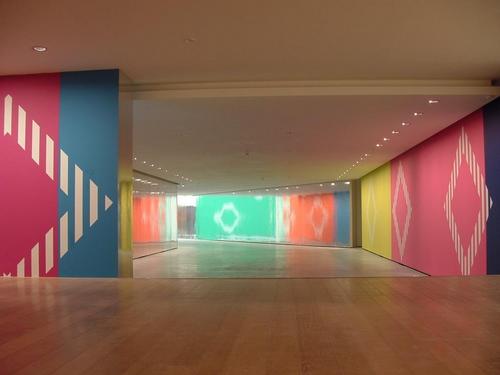18/2/2006
Wall Drawings
Albion, London
Daniel Buren, Robert Barry, Sol LeWitt

Daniel Buren, Robert Barry, Sol LeWitt
Albion brings together three artists whose work is seminal to the Minimalist and Conceptual art movements of the 1960s and 1970s. These three artists will be interacting with the existing structure of the gallery and merging both the space and their art in what will be a colour-filled, vibrant display of wall paintings, enhancing an unobstructed perception of the gallery’s architecture. Albion’s white walls and glass back window will be transformed by the words of Robert Barry and the monumental paintings of Daniel Buren and Sol Lewitt. The exhibition will bring to light the nuanced difference between Minimalism and Conceptualism through repetition, the varying conceptions and the de-materialisation of the space.
Although never a self-proclaimed movement, Minimalism refers to painting or sculpture made with an economy of means and reduced to the essentials of geometric abstraction. It is defined by non-hierarchical, mathematically regular compositions reduced to pure self-referential form, empty of all external references and was a rejection of the subjectivity of Abstract Expressionism. As with Conceptual art, what is important in Minimalist art, is the phenomenological basis of the viewer’s experience; how he perceives the internal relationships among the parts of the work and the parts of the whole. Daniel Buren has radically questioned the traditional expectations of form and the systems that support and manipulate it by reducing paintings to their simplest visual and physical elements. His interest in the literal components of a work of art has led him to explore both the material and ideological aspects of it that are not visible. Buren’s trademark 8.7 cm wide repetitive stripes are a ‘visual tool’, used to draw attention to the relationship between art and its support or surroundings. His work explores how different contexts or frameworks invest art with meaning and questions by working within, and in response to, a given location, which he sees as inextricable from the artwork itself.
‘Conceptual art’ denotes neither a uniform style nor a common theory. The term is associated with strongly abstract works that express an idea or thought process, which the viewer takes in and uses productively according to his or her own ideas and experiences. With Robert Barry’s work, words serve to emphasise the subtle differences in the perception of form and words in a new space and time as a viewpoint alters. For Barry, space, time and change are media in themselves. Since the early 1970s, Barry has worked almost exclusively with the medium of language, for words, removed from all syntactic context, are not art in themselves but refer to connected concepts that are communicated by language; one of which is the exploration of spatial experiences and dimensions, using the gallery as a medium with which to make a work of art. For Barry, an isolated word is loaded with meaning; it has a history but is in its purest form when removed from any defining context. Like an individual drawing, words work with the physical space in which they are presented so that the colours, space, architecture and the meaning of the words combine to create a receptive space into which the viewer penetrates.
With firm roots in Minimalism, but able to blur the definitions of both it and Conceptualism at times, Sol Lewitt uses seriality as a mode of composition and a thematic as his practice. Focussing on the vocabulary of simple geometric forms, he eliminates the play of the arbitrary, the expressive and the subjective, eschewing all traces of his hand and taste, for the import of underlying ideas. The architectural structure of the exhibition space determines each composition, which is then altered by the repetition and reduction that takes place during the execution of the work. As with an idea, the artwork’s existence is contingent and as with an exhibition, not only its dimensions but its duration is provisional. The measured logic and reasoning evidenced in his work betray neither a dogmatic commitment to mathematical calibration nor a belief in the transcendence of thought. On the contrary, with his monumental, burstingly colourful wall paintings, his works reveal compelling luminosity that speaks as much to the senses as to the intellect.
Lance Fung, who has curated the show for Albion was inspired by the gallery designed by the architects Foster and Partners, which led him to develop Wall Drawings. As this will be my first winter in London, the rumours of the grey and dreary days made me to consider the gallery space as a work of art and by integrating the works of Robert, Daniel and Sol. I imagined a completely different experience for those who visit Albion regularly. It is such a unique exhibition space that filling it with the dynamic and colourful works of artists that I both respect and am friends with, seems a fantastic opportunity to explore the two intersecting art historical movements, to highlight the architecture of the gallery and to ward off the lengthiness of winter. The patterns of colour will be painted directly on to the body of the gallery, which itself becomes a support for, and part of the art. Views through the gallery and to the river outside become an intrinsic part of the exhibition’s visual and ephemeral experience, which is further enhanced by the fact that the walls will be repainted white after the exhibition closes.
Albion
8 Hester Road - London



